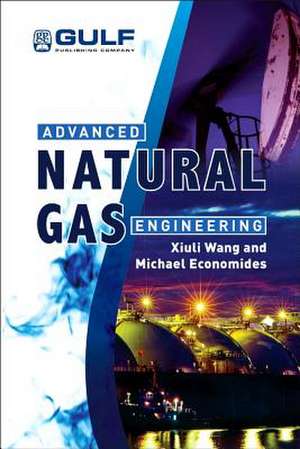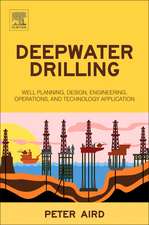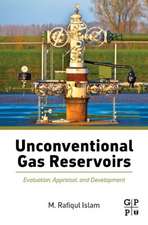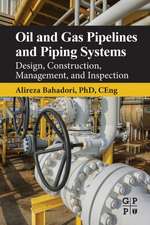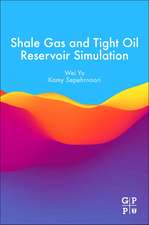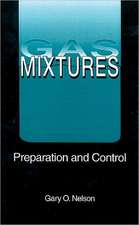Advanced Natural Gas Engineering
Autor Xiuli Wang, Michael Economidesen Limba Engleză Hardback – sep 2009
Preț: 937.29 lei
Preț vechi: 1083.81 lei
-14% Nou
Puncte Express: 1406
Preț estimativ în valută:
179.35€ • 187.73$ • 149.28£
179.35€ • 187.73$ • 149.28£
Carte tipărită la comandă
Livrare economică 24 martie-07 aprilie
Preluare comenzi: 021 569.72.76
Specificații
ISBN-13: 9781933762388
ISBN-10: 1933762381
Pagini: 368
Ilustrații: tables, charts & illus
Dimensiuni: 152 x 229 x 28 mm
Greutate: 0.7 kg
Ediția:New.
Editura: ELSEVIER SCIENCE
ISBN-10: 1933762381
Pagini: 368
Ilustrații: tables, charts & illus
Dimensiuni: 152 x 229 x 28 mm
Greutate: 0.7 kg
Ediția:New.
Editura: ELSEVIER SCIENCE
Cuprins
Preface
Reviews
List of Figures
List of Tables
List of Examples
1 Natural Gas Basics
1.1 Introduction
1.2 Geological Settings
1.3 Natural Gas Origins and Accumulations
1.4 Natural Gas Resources
1.4.1 Nonassociated Gas
1.4.2 Associated Gas
1.4.3 Unconventional Gas
1.5 Natural Gas Composition and Phase Behavior
1.5.1 Dry- and Wet-Gas Phase Behaviors
1.5.2 Retrograde-Condensate-Gas Phase Behavior
1.5.3 Associated Gas Phase Behavior
1.6 Natural Gas Properties
1.6.1 Gas Specific Gravity
1.6.2 Gas Deviation Factor
1.6.3 Gas Density
1.6.4 Gas Formation Volume Factor
1.6.5 Gas Compressibility
1.6.6 Gas Viscosity
1.6.7 Useful Correlations
1.7 Units and Conversions
1.8 References
2 Unique Issues in Natural Gas Exploration, Drilling, and Well Completion
2.1 Introduction
2.2 Exploration
2.3 Drilling
2.3.1 Natural Gas Well Drilling
2.3.2 Drilling Deep Wells
2.3.3 Drilling Damage
2.3.4 Gas Kick
2.4 Well Completions
2.4.1 Liquid Loading in Gas Wells
2.4.2 Casinghead Pressure
2.5 References
3 Natural Gas Production
3.1 Introduction
3.2 Darcy and Non-Darcy Flow in Porous Media
3.3 Gas Well Inflow under Darcy Flow
3.3.1 Steady State and Pseudosteady State Flow
3.3.2 Transient Flow
3.4 Gas Well Inflow under Non-Darcy Flow
3.4.1 Turbulent Flow in Gas Wells
3.4.2 Correlations for Turbulence in Vertical Gas Well
3.5 Horizontal Gas Well Inflow
3.6 Hydraulic Fracturing
3.6.1 Hydraulic Fracturing Overview
3.6.2 The Concept of Dimensionless Productivity Index
3.6.3 Unified Fracture Design (UFD)
3.6.4 Performance of a Hydraulically Fractured Well with Turbulence
3.6.5 Fracturing Horizontal Gas Wells
3.7 Well Deliverability
3.8 Forecast of Well Performance and Material Balance
3.9 References
4 Natural Gas Processing
4.1 Introduction
4.2 Natural Gas and Liquid Separation
4.2.1 Gravity Separation Mechanism
4.2.2 Three-Phase Separator Design
4.3 Natural Gas Dehydration—Water Removal
4.3.1 Water Content Determination
4.3.2 Natural Gas Hydrates
4.3.3 Adsorption Dehydration
4.3.4 Absorption Dehydration
4.4 Natural Gas Sweetening—Acid Gases Removal
4.5 References
5 Natural Gas Transportation—Pipelines and Compressed Natural Gas
5.1 Introduction
5.2 Pipelines
5.2.1 Pipeline Size
5.2.2 Compression
5.3 Marine CNG Transportation
5.3.1 CNG Carriers
5.3.2 Optimizing Vessel Capacity and Itineraries in CNG Transportation
5.4 References
6 Liquefied Natural Gas (LNG)
6.1 Introduction
6.2 The LNG Process
6.3 LNG Liquefaction
6.3.1 Thermodynamic Analysis of LNG Processes
6.3.2 Propane Precooled Mixed Refrigerant (PPMR™)/C3 MR Process
6.3.3 Optimized Cascade LNG Process
6.3.4 Single Mixed Refrigerant Loop Process
6.3.5 Mixed Fluid Cascade Process
6.3.6 Liquefin™ Process
6.3.7 Dual Mixed Refrigerant (DMR) Process
6.4 LNG Carriers
6.5 References
7 Gas-to-Liquids (GTL)
7.1 Introduction
7.2 Why GTL?
7.3 GTL Processes
7.4 GTL Based on Direct Conversion of Natural Gas
7.5 GTL Based on Indirect Conversion of Natural Gas
7.5.1 Basics
7.5.2 Natural Gas Reforming and Synthesis Gas
7.5.3 Fischer-Tropsch Synthesis
7.5.4 Product Upgrading
7.6 GTL Economics and Outlook
7.7 References
7.8 Appendix—Catalysis (Bartholomew and Farrauto, 2005)
8 Underground Natural Gas Storage
8.1 Introduction
8.2 Types of Underground Storage
8.3 Storage Measures
8.3.1 Total Gas Volume and Injected Gas Volume in Storage
8.3.2 Losses in Gas Storage
8.3.3 Injectivity in Gas Storage Well
8.4 Discussion
8.5 References
9 Natural Gas Supply, Alternative Energy Sources, and the Environment
9.1 Introduction
9.2 The Great Energy Dilemma
9.3 Advantages of Fossil Fuels
9.4 Energy Interchangeability versus Inflexibility
9.5 Regional Gas Supply Potential
9.6 Alternatives to Natural Gas Fired Electricity
9.6.1 Coal
9.6.2 Nuclear
9.6.3 Wind
9.6.4 Solar
9.7 Fundamentals of Electricity Generation from Alternative Energy Sources
9.7.1 Coal
9.7.2 Wind
9.7.3 Nuclear
9.7.4 Solar
9.8 Economics of Electricity Generation from Different Energy Sources
9.9 Environmental Impact of Fossil Fuels and Renewable Energy Sources
9.9.1 Environmental Impact of Coal
9.9.2 Environmental Impact of Nuclear Power Plants
9.9.3 Environmental Impact of Wind Turbines
9.9.4 Environmental Impact of PV Systems
9.10 References
Nomenclature
Index
